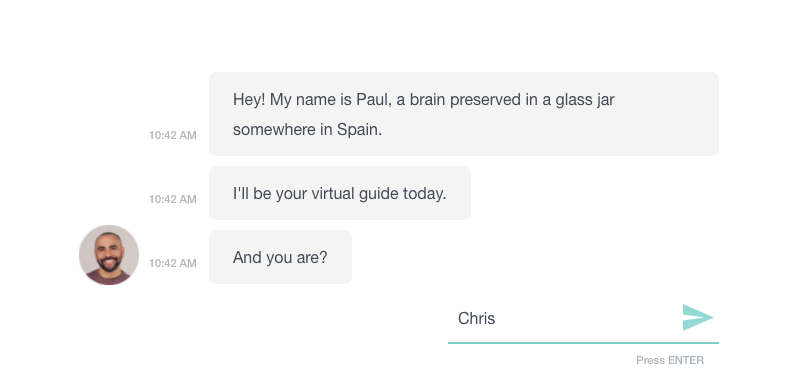Storytelling
In Tough Times, Self-Aware Marketing Helps You Stand Out & Save Money
The DC superhero Deadpool has many superpowers, but his strangest one is completely unique—he is the only superhero aware of his comic book status. In one issue, when asked why he did something, he retorts, “Because this is my book.” In his movie, he calls a particularly cliched comeback from his nemesis “lazy writing.”
Fans love it because Deadpool subverts expectations by being self-aware. You can see a similar idea at play when the writers behind the TV show “30 Rock” created an episode where the characters debate the merits of creating a TV show. Or, to get really meta, when a cafe’s sandwich board proclaims, “This is a sign.”
Right now, budgets are frozen, technology spend has decreased for the time being, and buyers of all manner are fatigued from the barrage of “We’re here for you in uncertain times” emails. This self-aware approach offers marketers a lifeline. And it can be done with playful humor or straightforward analysis.
Going meta—using your product to market itself—can be a clever way to draw attention, stretch your budget, and be disarmingly and refreshingly honest, all while still selling your product.
No but seriously, this is a sign
Self-aware marketing works, but for a different reason than it works in media. While “going meta” in pop culture surprises and delights because it shatters the so-called “fourth wall” and draws people out of what they’re watching, meta marketing typically draws them in. It demonstrates the product by showing it.
Take the billboard pictured below by 3M, the maker of duct tape. The tape appears to be supporting the billboard—an allusion to its utility as a fix-all. It’s cheeky but also demonstrative.

Among my favorite meta assets ever—so enjoyable that I’m still sharing it years later—is the survey software startup Typeform’s article “The Rise of the Conversational Interface.” In it, the author demonstrates the rise and uses of chatbots … by inserting a chatbot into the article. As you read, you can ask the author questions about the article.
When I interviewed Paul Campillo, now the company’s head of brand and communications, I learned that when he started writing it, Typeform didn’t even offer chatbots. Now they do. And it’s because the self-aware chatbot article was such a smash hit that buyers demanded it.
“We were pitching blog ideas about chatbots and someone had this idea to insert one into the article to provide a director’s cut commentary,” Campillo said. “We said, yeah that’s great. But we’ll need a chatbot.”
So they made one. A developer on the team spent a tremendous amount of time trying to understand the structure of a conversation with flowcharts. This raised new questions that influenced the article, which then influenced the chatbot.
“The article was a huge success,” Campillo explained. “People started pinging the heck out of me on Twitter asking, ‘Hey, is this available?’ and after a while, we built it. Now it’s one of Typeform’s three offerings.”
Typeform’s success fits a pattern. People increasingly want things they can see, try, and apply without sales pressure. Consumers are fatigued and fed up with traditional marketing tactics. If your product is good enough, enthusiastic users will indirectly do your marketing for you. Product-led advocates implore marketers to let buyers see your product organically in action rather than just pouring money into paid ad channels.

Plus, going meta can be easier on marketers who are trying to figure out how to do their jobs in the middle of a pandemic recession while also reckoning with the country’s long unaddressed racial issues. There is no easy way to be both sensitive and clever, so brands are finding simple ways to show what they’re selling with a more honest approach that doesn’t sacrifice creativity.
I’ve seen more and more companies launching webinars on how they use their own software. The really good ones are building trust with no-BS stories of trial and error—just people trying to figure it out and help other people. This path gives potential customers a chance to see what they’re paying for without PR glitz.
From the calendar scheduling app startup Chili Piper inserting “book a meeting” links into its own marketing assets to the real estate AI startup Skyline AI using its own data to run reports, more brands are trying to use their software to advertise it.
And you know what they’re all finding? It’s both earning them attention and, in many instances, saving them money.
The budgetary benefits of self-aware marketing
Now that I’ve highlighted self-aware content, you’ll start to see it everywhere.
“If you’re lucky enough to have a product you can show without having to shoehorn it in, there’s really nothing more cost effective,” said James Winter, VP of marketing at Brandfolder. “We offer a DAM—an organizational platform for your company’s creative assets. When our sales reps reach out to prospects about Brandfolder, they create a Brandfolder, fill it with that company’s own assets, and send a link. People love it. It’s genuinely useful to the situation, gets them invested and comfortable with the product early, gets the point across, and yeah, it doesn’t cost us a thing.”
Self-aware marketing can also save you agency fees—particularly in B2B software—since this kind of content relies on internal expertise. If it’s really clever and sparks a discussion on social media, you’ll get a better bang for your marketing buck.
The customer data platform Segment, for example, ran a billboard campaign across major cities that got some major social media pull-through. It demonstrated the frustration people feel with bad data by buying billboards that addressed each city by its rival city’s name—in San Francisco., it read, “Good morning, LA!”
This @segment billboard in SF is well done pic.twitter.com/1u22MoHzpd
— austin petersmith (@awwstn) April 9, 2019
“This actor in L.A. got caught up in the joke of it all and posted a picture of our billboard to his followers asking if we meant it to be there—twice,” said Maya Spivak, Head of Global Brand Marketing and Communications at Segment. “We got tens of thousands of these wonderful organic impressions.”
If cost savings, added attention, and selling without appearing to sell aren’t enough to convince you to try meta marketing, there’s one more benefit: It’s oddly liberating. Plus, if your boss asks, why are you dedicated so much time to a self-aware project, you can fire off your own laconic Deadpool retort: “Because it’s my article.”
Image by UzenzenGet better at your job right now.
Read our monthly newsletter to master content marketing. It’s made for marketers, creators, and everyone in between.




